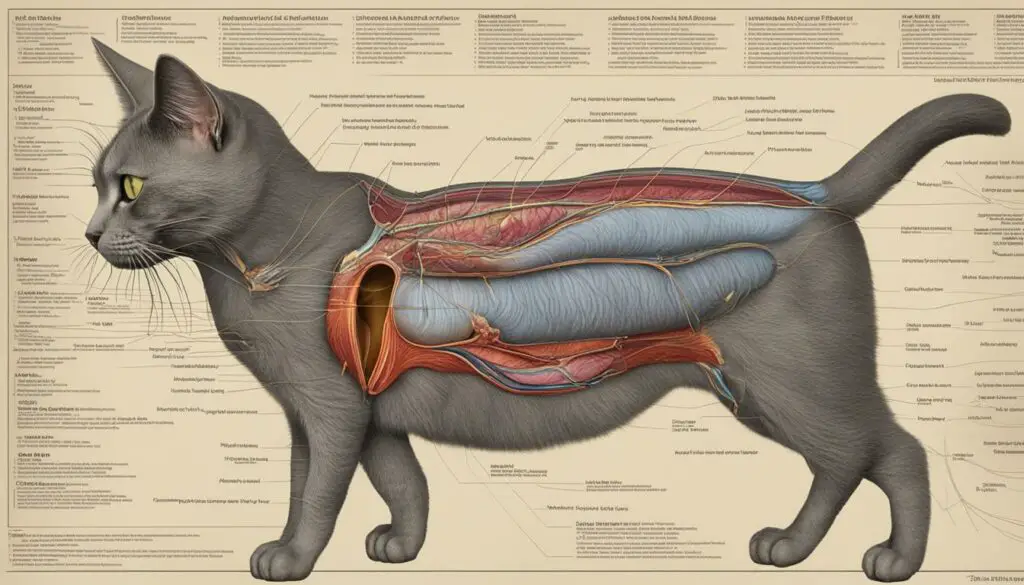As a cat owner, I understand that observing unusual behaviors in our feline companions can be concerning. One such behavior that may leave you puzzled is when your cat’s penis is out. But fret not, understanding the reasons behind this can provide valuable insights into your cat’s reproductive health.
When it comes to cat genitals, it’s essential to familiarize yourself with both normal and abnormal behaviors. By doing so, you can ensure your cat’s well-being and promptly address any potential issues that may arise.
Key Takeaways:
- Observing your cat’s reproductive organs is important for their overall health.
- Normal grooming behaviors include cleaning the genital area.
- Mother cats assist in cleaning their kittens’ private parts to stimulate bowel movements.
- Excessive genital grooming in adult cats may indicate urinary issues.
- Senior cats can develop vulvar fold pyoderma, requiring proper care and weight management.
Normal Grooming Behavior in Cats
Cats, both male and female, engage in grooming behaviors that include cleaning their genitals. This is a normal part of their grooming routine and helps maintain their cleanliness and hygiene. Grooming also provides cats with a sense of comfort and relaxation.
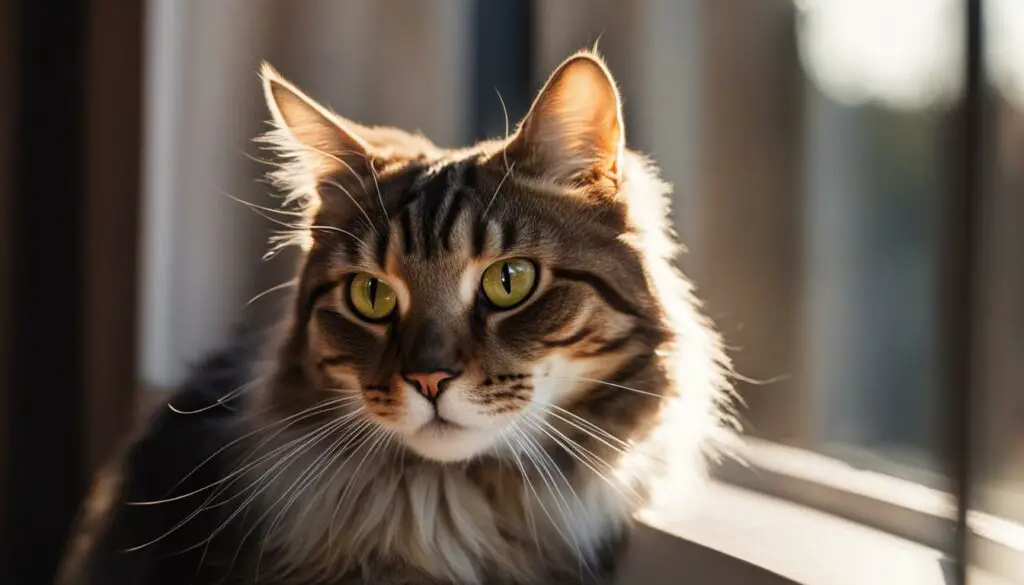
During grooming, cats use their tongues to lick and clean their genital area. This helps remove any dirt, debris, or excess moisture that may accumulate. Additionally, grooming stimulates blood flow and promotes the production of natural oils that keep their fur and skin healthy.
It is important to note that excessive grooming, such as constant licking or biting of the genital area, may indicate a problem and should be addressed by a veterinarian. It could be a sign of irritation, infection, or an underlying health issue that requires medical attention.
Kittens and Private Parts
When it comes to kittens and their private parts, there are a few important things to keep in mind. One of the first things to note is that female cats play a significant role in the cleanliness of their young kittens’ rear ends. It may sound strange, but this behavior serves an important purpose. By licking their kittens’ private parts, female cats help stimulate bowel movements, ensuring that their little ones can eliminate waste properly.
On the other hand, it’s crucial to monitor male kittens for a condition called feline cryptorchidism. This occurs when one or both testicles fail to fully descend by the age of two months. If left untreated, feline cryptorchidism can lead to serious health issues. It’s best to consult with a veterinarian if you suspect that your male kitten may have this condition. They can provide a proper diagnosis and recommend the necessary steps for treatment.
Table: Common Behaviors in Kittens
| Behavior | Description |
|---|---|
| Licking the genitals | Female cats assist in cleaning the rear ends of their young kittens, stimulating their bowel movements. |
| Undescended testicles | Male kittens should be monitored for feline cryptorchidism, a condition where one or both testicles do not fully descend. |
By staying informed about these behaviors and taking action when necessary, you can ensure the health and well-being of your adorable little feline friends.
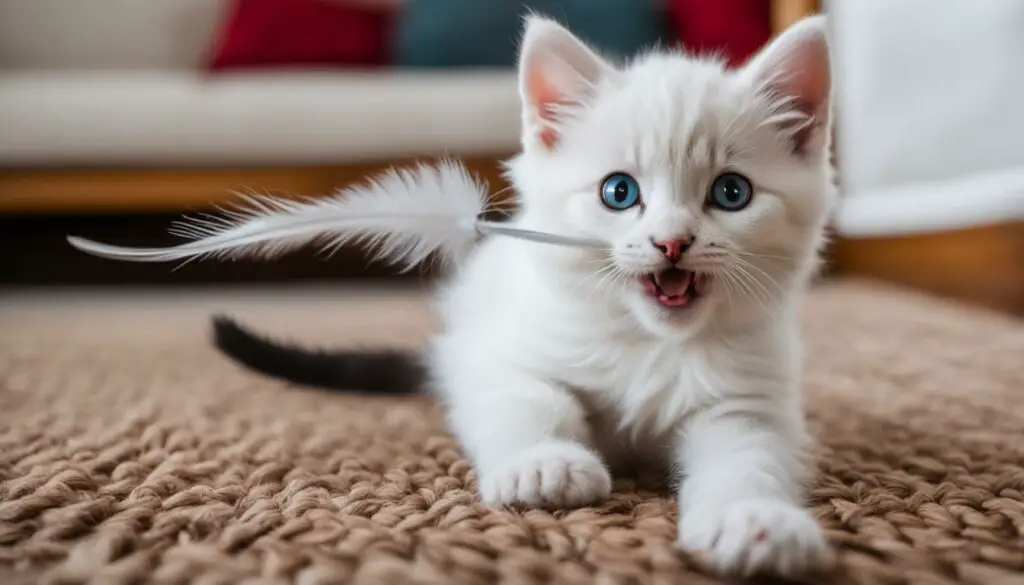
Adult Cats and Private Parts
When it comes to adult cats, occasional grooming of their genital area is perfectly normal and essential for maintaining cleanliness. However, excessive genital grooming can be a red flag for underlying urinary issues, such as a urethral obstruction. This condition occurs when the urethra becomes partially or completely blocked, preventing the cat from urinating normally.
Excessive grooming of the genital area can be a sign that your cat is experiencing discomfort or pain related to their urinary system. If you notice your cat obsessively licking or chewing their genitals, it’s important to seek veterinary attention immediately. Ignoring these symptoms can lead to life-threatening complications.
Table:
| Signs of Excessive Genital Grooming in Adult Cats | Possible Causes |
|---|---|
| Constant licking or chewing of the genital area | Urethral obstruction |
| Discomfort or pain while urinating | Urinary tract infection |
| Blood in the urine | Urolithiasis (bladder stones) |
If your cat is displaying excessive genital grooming, a veterinary examination is necessary to determine the underlying cause and provide appropriate treatment. Your veterinarian may perform diagnostic tests such as a urinalysis, blood work, or imaging to identify the specific issue. Prompt intervention is crucial to alleviate your cat’s discomfort and prevent further complications.

Possible Causes of Excessive Genital Grooming
1. Urethral Obstruction: This is a serious condition that requires immediate veterinary attention. It can occur due to the presence of stones, crystals, or a mucus plug in the urethra, causing a blockage and preventing urination.
2. Urinary Tract Infection: Bacterial infections in the urinary tract can cause inflammation and discomfort, leading to excessive grooming in an attempt to alleviate the discomfort.
3. Urolithiasis: Bladder stones can irritate the urinary tract and cause pain, resulting in excessive grooming of the genital area.
If you notice any of these signs or suspect that your cat is experiencing urinary issues, it’s crucial to consult with your veterinarian to determine the underlying cause and provide appropriate treatment.
Senior Cats and Private Parts
As cats age, they may face specific issues related to their genital area. One common problem is vulvar fold pyoderma, which occurs when bacteria accumulate in the skin folds around the vulva. This condition is more prevalent in senior cats that are less active and prone to weight gain. Maintaining proper hygiene, such as regularly cleaning the vulvar area, can help prevent and manage vulvar fold pyoderma. It is also important for senior cats to maintain a healthy weight through a balanced diet and regular exercise to minimize the risk of this condition.
In rare cases, surgical removal of excess skin may be necessary to alleviate the discomfort caused by vulvar fold pyoderma. However, this should only be considered after consultation with a veterinarian.

Obesity in senior cats can exacerbate the risk of vulvar fold pyoderma and other health issues. It is crucial to monitor their weight and provide them with a suitable diet to maintain a healthy body condition. By addressing obesity and practicing good hygiene, senior cats can enjoy a better quality of life and reduce the likelihood of developing genital-related problems.
Preventing Obesity in Cats
Preventing obesity in cats requires a combination of portion control, feeding a balanced diet, and encouraging physical activity. Consult with your veterinarian to determine the appropriate caloric intake for your senior cat based on their age, breed, and activity level. Regular play sessions, interactive toys, and environmental enrichment can help keep them active and engaged.
Monitoring Genital Health in Senior Cats
Regularly check your senior cat’s genital area for any signs of inflammation, discharge, or discomfort. If you notice any abnormalities, such as redness, swelling, or a foul odor, consult your veterinarian for a thorough examination. Early detection and intervention can prevent more serious complications and ensure your senior cat’s overall well-being.
| Signs of Vulvar Fold Pyoderma | Preventive Measures |
|---|---|
| Redness and irritation in the vulvar area | Regularly clean the vulvar folds and keep the area dry |
| Swelling or thickening of the vulvar skin folds | Encourage weight management through proper diet and exercise |
| Discharge or foul odor | Seek veterinary attention for appropriate diagnosis and treatment |
Urethral Prolapse in Cats
If you notice your cat experiencing difficulties in urination or observe a protrusion of visible tissue from their urethra, vaginal, or penile opening, they may be suffering from urethral prolapse. This condition, although more common in dogs, can also occur in cats and requires prompt veterinary attention to prevent further complications.
Urethral prolapse can be caused by various factors, including trauma, hormonal imbalances, or underlying medical conditions. Male cats are more susceptible to this condition due to the anatomical differences in their urinary system. In some cases, the prolapse may be accompanied by inflammation or infection, further exacerbating the discomfort experienced by the cat.
Treatment for urethral prolapse typically involves reducing the swelling, managing the underlying cause, and ensuring proper healing. Your veterinarian may prescribe medications to alleviate inflammation, provide antibiotics to prevent infection, or recommend surgical intervention in severe cases. Prompt veterinary care is essential to minimize the risk of complications and alleviate your cat’s discomfort.

| Common Signs of Urethral Prolapse in Cats | Treatment Options |
|---|---|
|
|
If you suspect your cat may be experiencing urethral prolapse or any other urinary tract issues, it is crucial to seek veterinary assistance immediately. Your veterinarian will conduct a thorough examination, perform diagnostic tests if necessary, and recommend the most appropriate treatment plan for your furry friend’s well-being.
Determining a Cat’s Sex
Determining a cat’s sex can be an important aspect of your cat’s overall healthcare. While it may be challenging, especially after neutering, there are certain visual cues that can help you identify your cat’s sex. It is crucial to respect your cat’s privacy and rely on the expertise of your veterinarian when making this determination.
For male cats, their penis is still intact even after neutering. By carefully locating the urethral opening under the tail, you may be able to see the penis. However, it is essential to handle your cat with care and avoid causing any discomfort or stress during this examination.
When examining a female cat, look for the absence of a visible penis and the presence of a vulva. The vulva is a small opening located beneath the anus. It is important to note that neutered cats may have less pronounced sexual characteristics, making it more challenging to determine their sex visually.
While these visual cues can provide some insight into your cat’s sex, it is always recommended to consult with your veterinarian for confirmation. They have the expertise and experience to accurately determine your cat’s sex and provide you with any additional information or advice regarding your cat’s reproductive health.

Summary:
- Determining a cat’s sex can be challenging, especially after neutering.
- Male cats may still have their penis intact, which can be seen by locating the urethral opening under the tail.
- Female cats will have a vulva, a small opening located beneath the anus.
- It is important to respect your cat’s privacy and rely on your veterinarian’s expertise when identifying their sex.
Understanding Urethral Health
Proper understanding of urinary health in cats is crucial for their overall well-being. Cats are prone to urinary issues such as urethral obstruction and urinary tract infections. These conditions can have serious consequences if not addressed promptly. Regular veterinary check-ups and monitoring of urinary behaviors can help prevent and manage these issues.
Cat urinary issues, such as urethral obstruction, occur when the flow of urine is blocked. This can result in discomfort, pain, and even life-threatening complications if left untreated. Symptoms of urethral obstruction may include frequent urination attempts, straining to urinate, and blood in the urine. It is important to seek immediate veterinary attention if you notice any of these signs.
Urinary tract infections (UTIs) can also affect cats and cause discomfort and pain. Factors such as stress, a weakened immune system, and underlying medical conditions can increase the risk of UTIs. If you notice any changes in your cat’s urination habits, such as increased frequency or difficulty, it is important to have them evaluated by a veterinarian.
| Common Urinary Issues in Cats | Symptoms |
|---|---|
| Urethral Obstruction | – Frequent urination attempts – Straining to urinate – Blood in the urine |
| Urinary Tract Infections | – Increased frequency of urination – Difficulty urinating – Urine accidents outside the litter box |
Prevention is key when it comes to maintaining urinary health in cats. Encouraging proper hydration through fresh water and a balanced diet can help prevent the formation of crystals or stones in the urinary tract. Providing multiple litter boxes in a stress-free environment can also help reduce the risk of urinary issues. Regular veterinary check-ups and urine analysis can detect early signs of urinary problems, allowing for timely intervention.
Preventive Measures for Urethral Prolapse
When it comes to preventing urethral prolapse in cats, there are a few options to consider. One of the most effective methods is neutering, also known as spaying or castration. Neutering involves the removal of the reproductive organs, including the uterus and ovaries in females, and the testes in males. This procedure not only prevents unwanted pregnancies but also reduces the risk of various reproductive issues, including urethral prolapse.
Neutering eliminates the hormonal changes associated with heat cycles in females and diminishes the chances of certain medical conditions, such as uterine infections and mammary tumors. In males, neutering helps prevent testicular cancer and reduces the risk of prostate problems. By removing the reproductive organs, neutering can help maintain the overall health and well-being of your cat.
Benefits of Neutering Cats
Neutering has several benefits beyond preventing urethral prolapse. Here are some key advantages:
- Reduces the likelihood of roaming behavior and the risk of your cat getting lost or injured outdoors.
- Decreases the urge to spray strong-smelling urine to mark territory, which can help maintain a cleaner and more pleasant living environment.
- Prevents the onset of certain reproductive-related behaviors such as yowling, aggression, and unwanted mating attempts.
- Contributes to controlling the cat population by preventing the birth of unwanted kittens.
Overall, neutering is a proactive measure to promote the reproductive health and well-being of your cat. Consult with your veterinarian to determine the ideal age and timing for neutering, as it may vary depending on your cat’s breed, overall health, and individual circumstances.
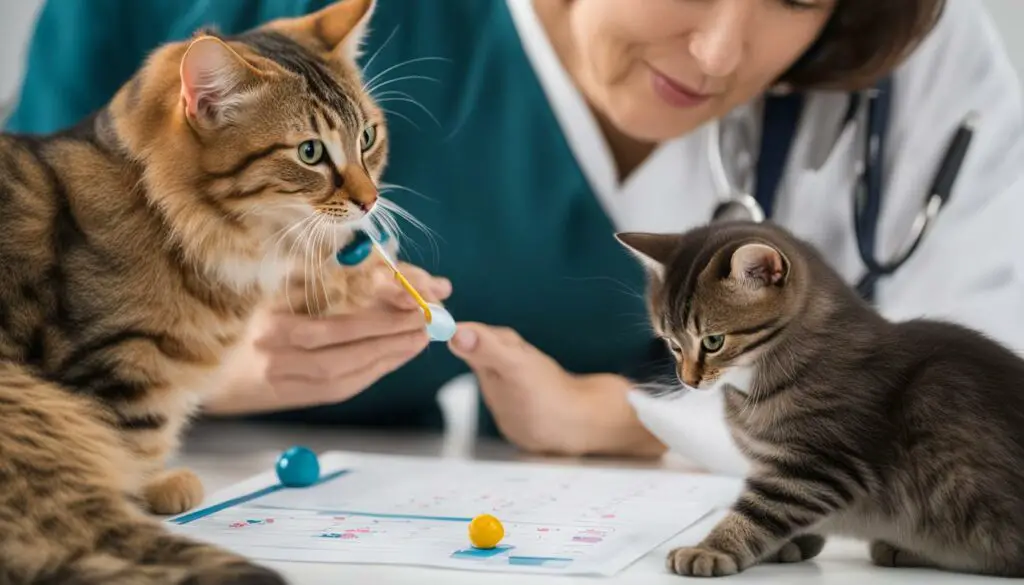
| Benefits of Neutering Cats | Preventing Urethral Prolapse |
|---|---|
| Reduces the likelihood of roaming behavior and the risk of your cat getting lost or injured outdoors. | Neutering eliminates the hormonal changes associated with heat cycles in females and diminishes the chances of various reproductive issues, including urethral prolapse. |
| Decreases the urge to spray strong-smelling urine to mark territory, which can help maintain a cleaner and more pleasant living environment. | By removing the reproductive organs, neutering can help maintain the overall health and well-being of your cat. |
| Prevents the onset of certain reproductive-related behaviors such as yowling, aggression, and unwanted mating attempts. | Neutering helps prevent testicular cancer and reduces the risk of prostate problems in males. |
| Contributes to controlling the cat population by preventing the birth of unwanted kittens. | Neutering eliminates the risk of mammary tumors and uterine infections in females. |
Observing Changes in Genital Area
As a responsible cat owner, it is crucial to regularly monitor your cat’s genital area for any signs of abnormalities. By paying close attention to changes in this area, you can identify potential health issues and ensure prompt veterinary care when needed. Here are some key signs to watch out for:
- Excessive licking or grooming of the genital area: While cats may groom their genitals as part of their normal routine, excessive licking can indicate an underlying issue such as a urinary tract infection or irritation.
- Inflammation or redness: Swelling, redness, or inflammation in and around the genital area may be a sign of infection or an allergic reaction.
- Presence of discharge: Any abnormal discharge, such as blood or pus, should be evaluated by a veterinarian as it could indicate an infection or reproductive issue.
- Unusual odor: A strong or foul odor emanating from the genital area may be a sign of infection or poor hygiene.
- Pain or sensitivity: If your cat displays discomfort or sensitivity when you touch their genital area, it is important to consult with a veterinarian for further evaluation.
Regularly examining your cat’s genital area can help you detect and address any potential issues early on, ensuring their reproductive health and overall well-being. If you notice any of these signs or have concerns about your cat’s genital area, it is always best to seek veterinary assistance for a proper diagnosis and appropriate treatment.
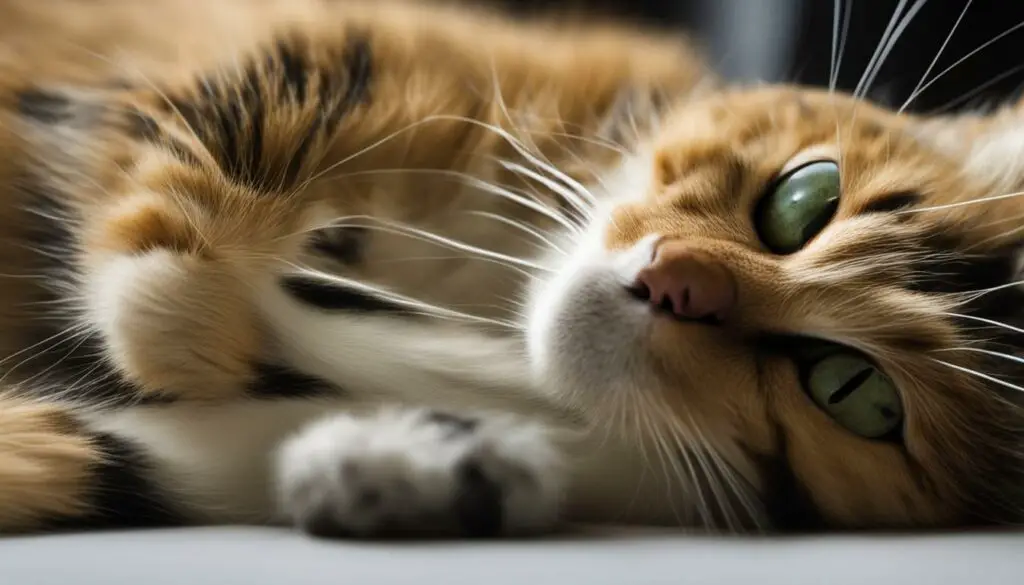
Importance of Veterinary Examinations
Regular veterinary examinations are essential for maintaining the reproductive health of your cat. These check-ups allow for comprehensive assessments of your cat’s overall well-being, including their reproductive system. By scheduling routine visits with a trusted veterinarian, you can ensure early detection of any potential issues and receive appropriate interventions to keep your cat healthy.
During a veterinary examination, your cat’s reproductive health will be assessed through various means. The veterinarian will perform a physical examination, checking for any abnormalities or signs of infection in the genital area. They may also recommend specific tests, such as a urinalysis, to evaluate the function of the urinary tract. These assessments help identify any underlying reproductive health issues and ensure timely treatments.
In addition to monitoring your cat’s reproductive organs, regular veterinary check-ups also provide an opportunity for preventive care. Your veterinarian can discuss the benefits of neutering or spaying your cat to prevent certain reproductive issues and control the cat population. They can also provide guidance on maintaining your cat’s overall health, including proper nutrition, exercise, and hygiene practices.
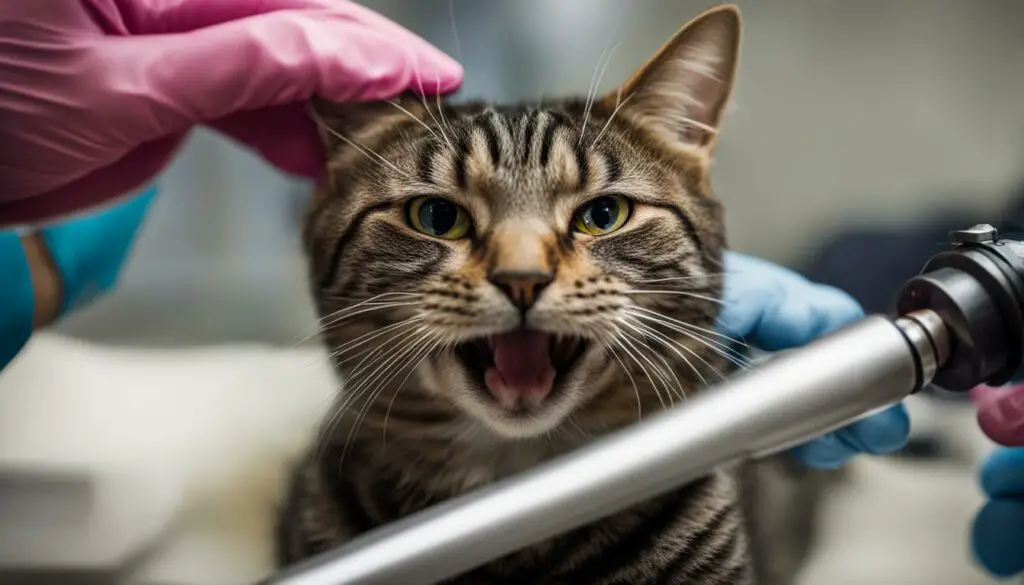
Benefits of Veterinary Check-ups for Cats:
- Early detection of reproductive health issues.
- Opportunity for preventive care, such as neutering or spaying.
- Comprehensive assessments of overall well-being.
- Guidance on maintaining proper nutrition, exercise, and hygiene.
Regular veterinary check-ups are crucial for ensuring the reproductive health of your cat. By staying proactive and seeking professional assessments, you can provide the necessary care and interventions to keep your furry friend healthy and happy.
| Benefits of Veterinary Check-ups for Cats |
|---|
| Early detection of reproductive health issues |
| Opportunity for preventive care, such as neutering or spaying |
| Comprehensive assessments of overall well-being |
| Guidance on maintaining proper nutrition, exercise, and hygiene |
Supporting Your Cat’s Well-Being
Ensuring the health and well-being of your cat is essential for their reproductive health. By taking proactive measures, you can contribute to their overall well-being and happiness. Here are some key aspects of cat health care to consider:
Proper Nutrition:
Feeding your cat a balanced and nutritious diet is crucial for their overall health. Consult with your veterinarian to determine the appropriate type and amount of food for your cat’s specific needs. Provide them with a diet rich in high-quality protein, vitamins, and minerals to support their reproductive health.
Regular Exercise:
Keeping your cat active and engaged is important for their physical and mental well-being. Provide them with opportunities to play and exercise, such as interactive toys and scratching posts. Regular exercise helps prevent obesity, promotes healthy blood flow, and supports optimal reproductive function.
Maintaining Hygiene:
Proper hygiene is vital for your cat’s reproductive health. Regularly groom your cat to keep their genital area clean and free from debris. Pay attention to any signs of excessive grooming, which could indicate an underlying health issue that requires veterinary attention.
Creating a stress-free environment:
Cats are sensitive creatures, and stress can have a negative impact on their overall health, including their reproductive system. Provide a calm and secure environment for your cat, minimizing exposure to loud noises, excessive activity, or other stressors. This will help maintain their reproductive health and overall well-being.
| Aspect | Tips |
|---|---|
| Proper Nutrition | Consult with a veterinarian for a balanced and nutritious diet tailored to your cat’s needs. |
| Regular Exercise | Engage your cat in daily playtime activities to keep them physically and mentally stimulated. |
| Maintaining Hygiene | Regularly groom your cat and keep their genital area clean to prevent infections and other issues. |
| Creating a stress-free environment | Provide a calm and secure space for your cat, minimizing stressors that can affect their reproductive health. |
By prioritizing these aspects of cat care, you can support your cat’s overall well-being, including their reproductive health. Remember to consult with your veterinarian for personalized advice based on your cat’s specific needs and circumstances.
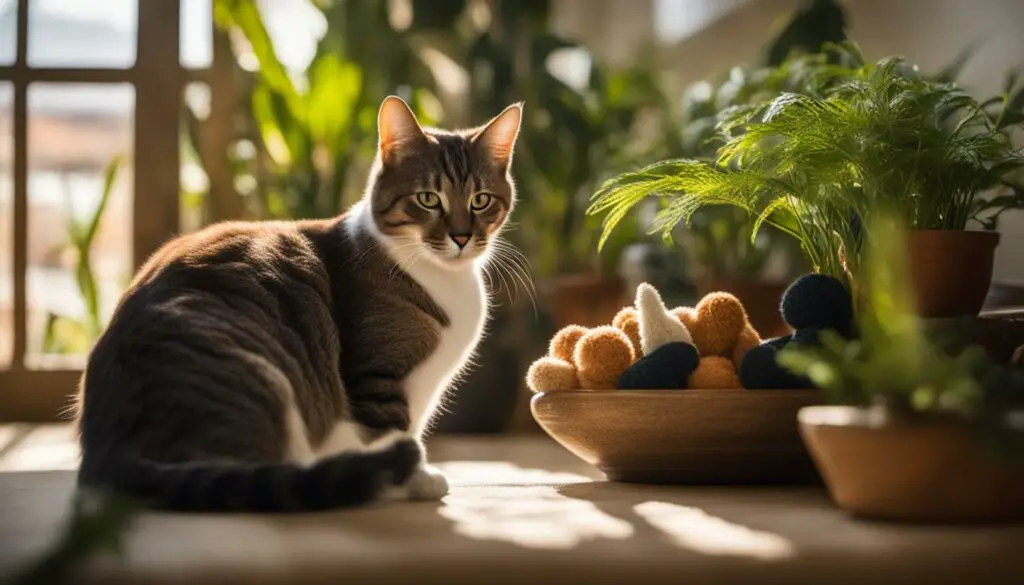
Cat Reproductive Health Issues: When to Seek Veterinary Consultations
When it comes to your cat’s reproductive health, it’s essential to be proactive and attentive. Monitoring your cat’s behavior and physical changes is crucial in identifying any potential issues. However, there are times when veterinary assistance is necessary to ensure the well-being of your feline friend.
If you notice any concerning symptoms or behaviors related to your cat’s reproductive health, such as excessive genital grooming, unusual discharge, or difficulty urinating, it’s important to seek professional advice. A qualified veterinarian can provide accurate diagnoses through physical examinations, blood tests, and imaging if needed. They can also recommend appropriate treatment options based on the underlying cause.
Remember, early intervention is key to preventing complications and promoting a healthy reproductive system in your cat. Regular veterinary consultations allow for timely assessments and ensure that any potential issues are addressed promptly. Don’t hesitate to reach out to your veterinarian for guidance and support regarding your cat’s reproductive health.
Signs That May Indicate the Need for Veterinary Consultations
- Excessive genital grooming
- Unusual discharge from the genital area
- Blood in urine or difficulty urinating
- Swollen or inflamed genital area
- Behavioral changes, such as increased aggression or restlessness
By staying vigilant and seeking professional help when necessary, you can ensure that your cat’s reproductive health is properly managed. Remember, your veterinarian is your best resource for accurate advice and guidance tailored to your cat’s specific needs.
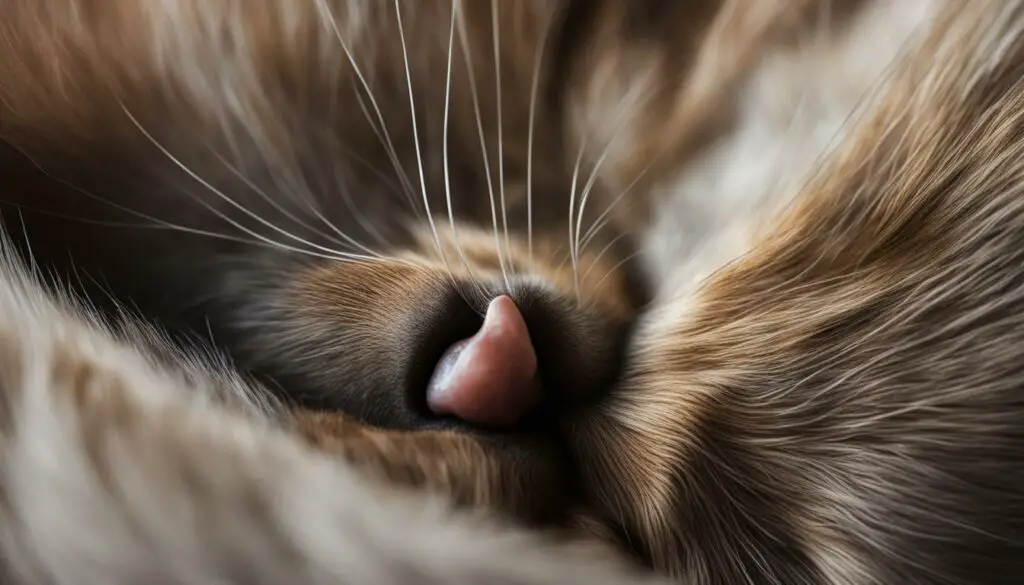
| Common Signs That May Indicate the Need for Veterinary Consultations | Possible Causes | Treatment Options |
|---|---|---|
| Excessive genital grooming | Urinary tract infection, reproductive organ inflammation | Medication, topical treatments, behavioral modifications |
| Unusual discharge from the genital area | Infection, hormonal imbalance, reproductive organ abnormalities | Antibiotics, hormone therapy, surgical intervention if necessary |
| Blood in urine or difficulty urinating | Urinary tract infection, bladder stones, urethral obstruction | Urinary catheterization, surgery, medication |
| Swollen or inflamed genital area | Infection, trauma, allergic reaction | Antibiotics, anti-inflammatory medications, wound care |
| Behavioral changes, such as increased aggression or restlessness | Hormonal imbalance, underlying medical condition | Hormone therapy, behavior modification, further diagnostic tests |
Understanding Your Cat’s Unique Needs
When it comes to cat reproductive needs and breeding considerations, it’s important to understand that each cat is unique. Factors such as breed, age, and overall health can greatly impact their reproductive capabilities and requirements. By taking these factors into account, you can make informed decisions about breeding, neutering, or spaying your cat.
Factors to Consider
When evaluating your cat’s unique reproductive needs, start by considering their breed. Some breeds may be more prone to certain reproductive issues or have specific gestation periods. Consulting with a reputable breeder or veterinarian who specializes in your cat’s breed can provide valuable insights into their unique needs.
Age is another crucial consideration. While cats can reach sexual maturity as early as four to six months old, it’s generally recommended to wait until they are at least one year old before considering breeding. Older cats may have different reproductive health requirements, so it’s important to adapt their care accordingly.
Lastly, overall health plays a significant role in a cat’s reproductive abilities. Cats with underlying health conditions or genetic predispositions may require additional monitoring or specialized care. Regular veterinary check-ups can help identify and address any health issues that may impact their reproductive health.
| Factors to Consider | Implications for Reproductive Needs |
|---|---|
| Breed | Some breeds may have specific reproductive issues or requirements. |
| Age | Young cats may have different needs than older cats, and timing for breeding should be carefully considered. |
| Overall Health | Underlying health conditions can impact a cat’s reproductive abilities and may necessitate specialized care. |
By understanding your cat’s unique reproductive needs and considering these factors, you can make informed decisions that prioritize their health and well-being. Remember, consulting with a veterinarian who can provide personalized guidance based on your cat’s individual characteristics is always recommended.
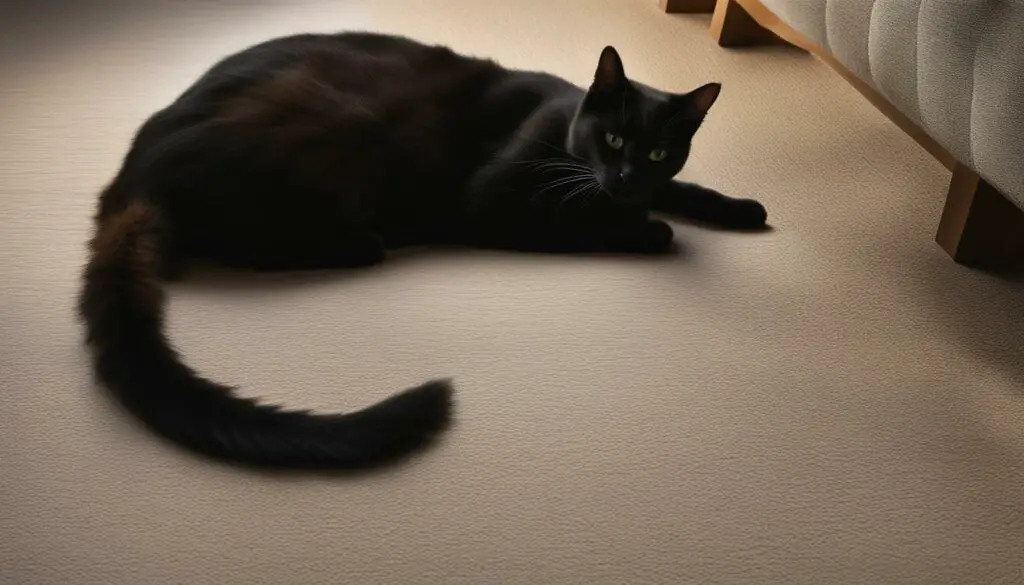
Responsible Pet Ownership
As a cat owner, it is essential to embrace responsible pet ownership to ensure the well-being of your feline companion. This goes beyond providing food, shelter, and love. It encompasses measures to control the cat population and promote reproductive health. By taking proactive steps, you contribute to the overall welfare of cats and create a more sustainable and compassionate community.
One crucial aspect of responsible cat ownership is spaying or neutering your cat. This procedure not only helps control the cat population but also offers numerous health benefits. Neutering male cats reduces the risk of testicular cancer and aggression, while spaying female cats prevents uterine infections and certain types of cancers. Additionally, spaying eliminates the discomfort and complications associated with heat cycles.
Another important consideration is educating yourself and others about the importance of responsible cat ownership. By spreading awareness about the benefits of spaying and neutering, you can influence others to make informed decisions for their own pets. This can help reduce the number of stray cats and prevent the suffering that comes with overpopulation.
Benefits of Responsible Cat Ownership
- Helps control the cat population and reduces the number of stray cats
- Improves the overall health and well-being of your cat
- Prevents certain types of cancers and infections
- Reduces undesirable behaviors such as marking and aggression
- Creates a more harmonious and compassionate community for both humans and cats
By being a responsible cat owner, you demonstrate your commitment to the welfare of your pet and the larger feline community. Take the necessary steps to spay or neuter your cat and encourage others to do the same. Together, we can create a world where every cat is loved, cared for, and valued.
| Benefits of Responsible Cat Ownership | Actions You Can Take |
|---|---|
| Helps control the cat population and reduces the number of stray cats | Spay or neuter your cat |
| Improves the overall health and well-being of your cat | Provide regular veterinary care, balanced diet, and exercise |
| Prevents certain types of cancers and infections | Spay or neuter your cat |
| Reduces undesirable behaviors such as marking and aggression | Spay or neuter your cat |
| Creates a more harmonious and compassionate community for both humans and cats | Spread awareness about responsible cat ownership |
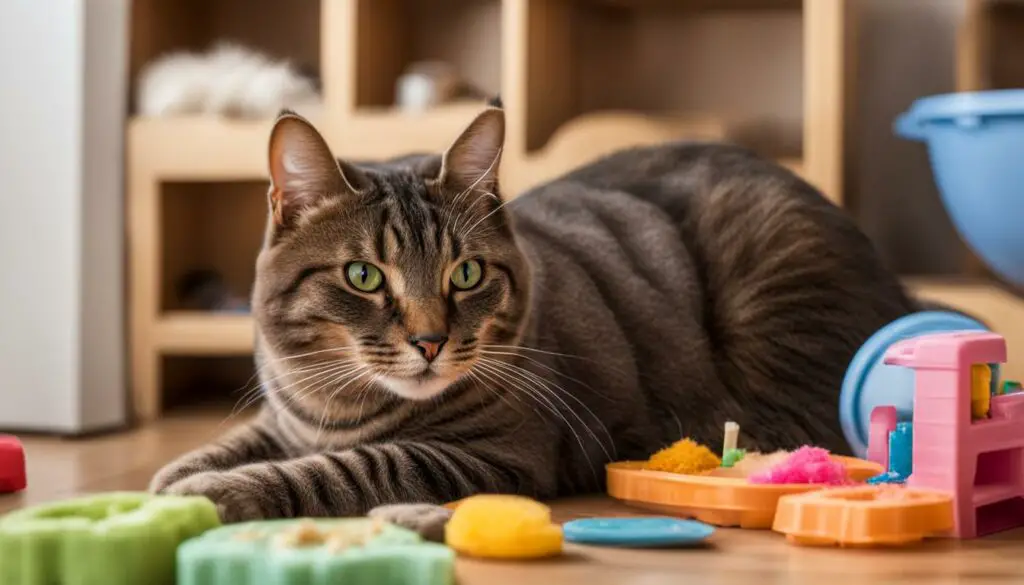
Conclusion
In conclusion, understanding your cat’s reproductive health is essential for their overall well-being. By being aware of normal behaviors, such as grooming and cleaning of the genital area, you can ensure that your cat is maintaining good hygiene. Additionally, monitoring kittens for conditions like feline cryptorchidism and addressing any excessive genital grooming in adult cats can help prevent potential health issues.
Furthermore, it is important to be aware of conditions like urethral prolapse and seek immediate veterinary attention if you notice any signs of urinary obstruction or infection. Regular veterinary check-ups and observations of your cat’s genital area are crucial for early detection and treatment of any abnormalities or changes.
As a responsible cat owner, it is your duty to provide your cat with proper care and support their overall well-being. This includes providing a balanced diet, regular exercise, and maintaining a stress-free environment. By taking these steps, consulting with a veterinarian, and being mindful of your cat’s unique reproductive needs, you can ensure that they lead a healthy and happy life.
Remember, responsible pet ownership is not only about individual cat care but also about contributing to the control of the cat population. Responsible breeding practices, neutering or spaying, and promoting awareness of the importance of reproductive health are all part of being a responsible cat owner. By doing so, you are making a positive impact on the welfare of cats as a whole.
FAQ
Why is my cat’s penis out?
Understanding why your cat’s penis may be out can provide insights into their reproductive health. It is important to explore the normal and abnormal behaviors related to cat genitals to ensure your cat’s well-being.
Is it normal for cats to groom their genitals?
Yes, cats, both male and female, engage in grooming behaviors that include cleaning their genitals. This is a normal part of their grooming routine and helps maintain their cleanliness and hygiene.
What should I look out for in kittens’ private parts?
Female cats assist in cleaning the rear ends of their young kittens, stimulating their bowel movements. It is important to monitor male kittens for feline cryptorchidism, a condition where one or both testicles do not fully descend by the age of two months. This condition can lead to health issues and should be addressed by a veterinarian.
Can excessive grooming of the genital area in adult cats be a sign of a problem?
Yes, adult cats may display excessive grooming of their genitals, which can be a sign of urinary issues such as urethral obstruction. This condition requires immediate veterinary attention to prevent life-threatening complications. Regular grooming of the genital area is normal for both male and female cats, but any excessive grooming should be addressed by a veterinarian.
Do senior cats have specific genital health concerns?
Senior cats, especially those who are less active and prone to weight gain, may develop vulvar fold pyoderma due to the accumulation of bacteria in the skin folds around the vulva. Keeping the area clean and helping the cat lose weight can help prevent and manage this condition. In rare cases, surgical removal of excess skin may be necessary.
What is urethral prolapse in cats?
Urethral prolapse occurs when the urethral mucosal lining protrudes from the urethra, vaginal, or penile opening, leading to visible tissue. While it can affect both dogs and cats, in cats, it often causes difficulties in urination. Treatment is required in case of infection or underlying medical conditions.
How can I determine my cat’s sex?
Determining a cat’s sex can be challenging, especially after neutering. Male cats still have their penis intact, and it can be seen by locating the urethral opening under the tail. However, it is important to respect the cat’s privacy and rely on your veterinarian’s expertise when identifying their sex.
Why is urinary health important for cats?
Proper understanding of urinary health in cats is crucial for their overall well-being. Urethral obstruction, urinary tract infections, and other urinary issues can have serious consequences if not addressed promptly. Regular veterinary check-ups and monitoring of urinary behaviors can help prevent and manage these conditions.
How can I prevent urethral prolapse in cats?
Unfortunately, there are no specific preventive measures for urethral prolapse. However, if a cat shows a high risk of recurrence, neutering may be recommended as a preventative measure. Neutering can help reduce the likelihood of certain reproductive issues in cats.
How often should I observe my cat’s genital area for changes?
Regularly observing the genital area of your cat is essential to identify any physical changes or abnormalities. Look for signs of inflammation, infection, or excessive grooming. Any unusual symptoms should be brought to the attention of a veterinarian for further evaluation.
How important are veterinary examinations for my cat’s reproductive health?
Routine veterinary examinations play a crucial role in assessing a cat’s reproductive health. Regular check-ups allow for early detection of any issues and provide appropriate interventions to ensure the cat’s well-being. Make sure to schedule regular visits with a trusted veterinarian for comprehensive assessments.
What can I do to support my cat’s reproductive well-being?
Taking care of your cat’s overall health and well-being is essential for their reproductive health as well. Providing a balanced diet, engaging in regular exercise, maintaining proper hygiene, and ensuring a stress-free environment can contribute to their overall reproductive health. Consult with your veterinarian for personalized recommendations.
When should I seek veterinary assistance for my cat’s reproductive health?
If you notice any concerning symptoms or behaviors related to your cat’s reproductive health, it is important to seek veterinary assistance. Only a qualified veterinarian can provide accurate diagnoses and recommend appropriate treatment options. Do not hesitate to reach out to your veterinarian for guidance.
Are there unique considerations for each cat’s reproductive needs?
Each cat has unique reproductive needs and considerations. Factors such as breed, age, and overall health can affect their reproductive capabilities and requirements. Understanding these individual needs can help you make informed decisions regarding breeding, neutering, or spaying. Consult with a reputable breeder or veterinarian for guidance.
How can I be a responsible cat owner in terms of reproductive health?
Responsible pet ownership includes taking measures to control the cat population and ensure the well-being of individual cats. This can be achieved through responsible breeding practices, neutering or spaying, and promoting awareness of the importance of reproductive health in cats. By being a responsible cat owner, you contribute to the overall welfare of cats.
What is the conclusion regarding cat reproductive health?
Understanding why a cat’s penis may be out is crucial for their reproductive health. By recognizing normal behaviors, identifying potential issues, and seeking veterinary assistance when needed, you can ensure the well-being of your furry friend. Remember, responsible pet ownership and regular veterinary care are key to maintaining your cat’s reproductive health.

